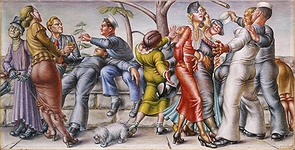
|
|
|
|||||||||
| Paul Cadmus (1904–99) | ||||||||||
| Born in Manhattan into an artistic family, Cadmus began drawing at an early age and entered art school at fourteen, where he studied for the next ten years. He later worked for an advertising agency before traveling to Europe. After joining the Public Works of Art Project, he painted the controversial The Fleet's In! in 1934, which brought him instant fame. His etchings began to be purchased by museums, and he received critical acclaim. The first exhibition of his works was held in Manhattan in 1937, after which he continued working in commercial illustration before dedicating himself entirely to fine art. Cadmus' paintings, often classified as magical realism, have a classical appearance influenced by 16th-century painter Luca Signorelli in both style and subject matter, yet they contain contemporary and revolutionary themes. His favourite subject was people, though he found the masses repulsive. His works are satirical, known for their vivid, exaggerated, and erotic depictions of men and women, executed in bold colours to reflect the vulgarity of life. For his early works, Cadmus rarely used models, instead sketching his paintings beforehand and relying on memory and careful attention to detail. He became a member of the National Academy of Design in 1979. Cadmus died in Weston, Connecticut. | ||||||||||
| |
||||||||||
|
Other works |
||||||||||
| |
||||||||||










